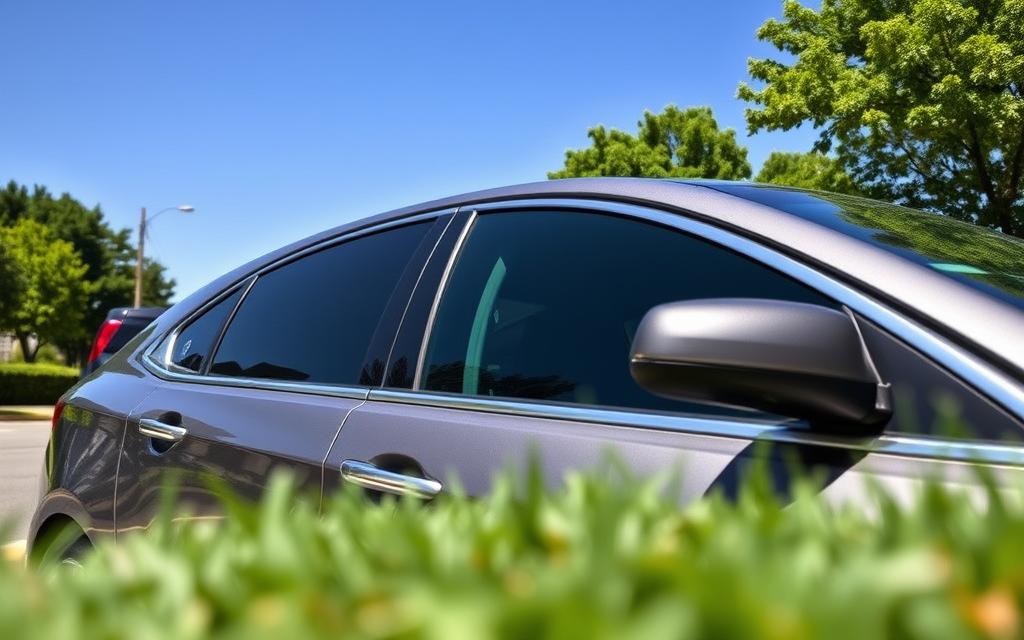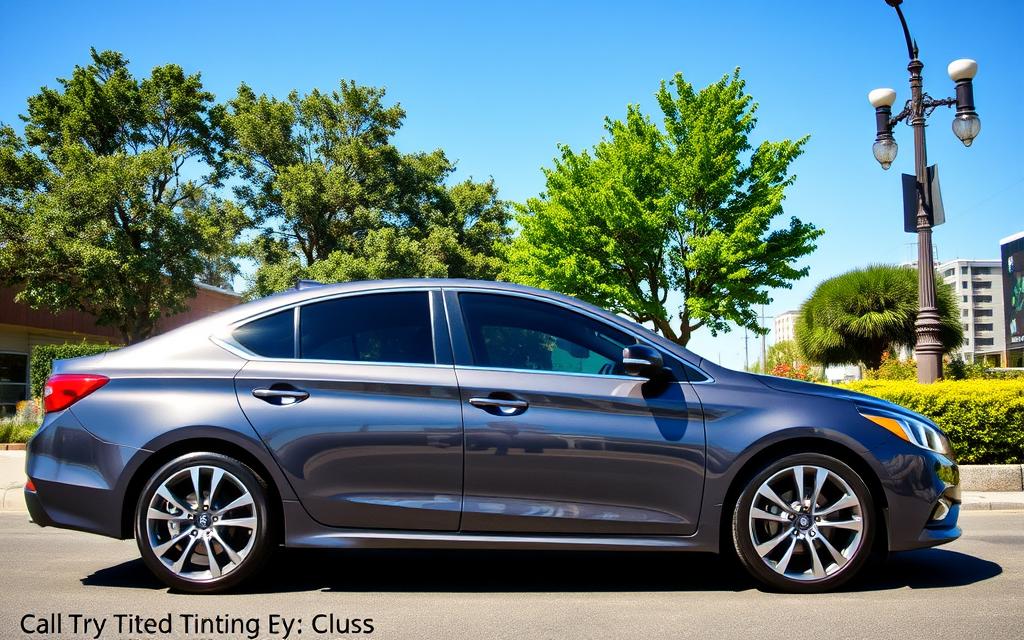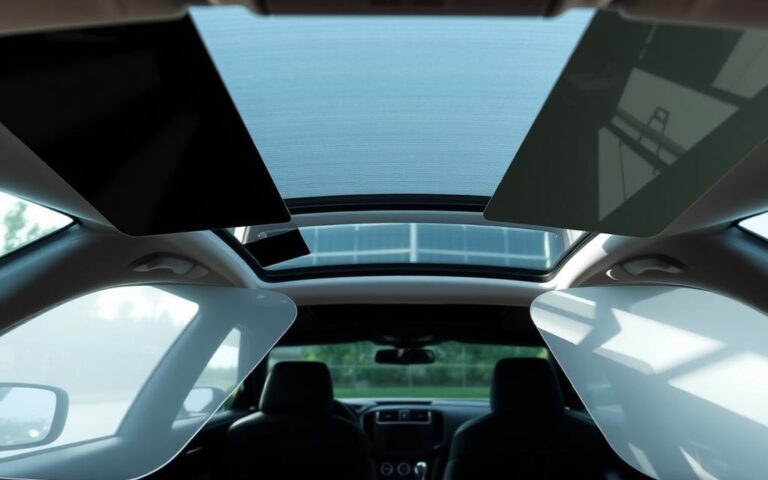Our website is dedicated to helping you take the best care of your vehicles. Whether you own a car or a motorbike, we provide helpful tips and expert advice to keep them in top condition.
North Carolina Tint Laws for Sedans with all Wheel
In North Carolina, sedans with all wheel drive must have at least 35% Visible Light Transmission (VLT) for all windows except the front windshield. The front windshield can’t have tint below the AS-1 line. It’s important to know these laws to avoid fines and keep your vehicle safe.
North Carolina’s tint laws for sedans with all wheel drive help ensure everyone follows the same rules. Sedans need 35% tint on all windows except the front windshield. Knowing these rules is key for safety and following state laws.
Key Takeaways
- North Carolina tint laws require a minimum of 35% VLT for all windows except the front windshield.
- The front windshield should have no tint below the AS-1 line.
- Window tint regulations in North Carolina apply to all vehicle types, including sedans, trucks, SUVs, and vans.
- Specific restrictions are in place for front side windows, rear side windows, and rear windshields.
- Understanding north carolina tint laws for sedans with all wheel drive is crucial to avoid penalties and ensure vehicle safety.
- Compliance with state laws is essential to reduce the risk of accidents and ensure driver visibility.
Window Tint Regulations in North Carolina
North Carolina’s window tint laws were made in 2001. They aim to keep drivers safe and reduce accidents. The laws use the Visible Light Transmission (VLT) percentage to measure light passing through the film. For sedans, the legal tint percentage is 35% for all windows except the front windshield.
The tint laws for sedans in North Carolina balance tinting needs with road safety. These laws apply to all vehicles in the state, including those with all-wheel drive. Knowing these laws helps avoid fines and ensures you’re following the rules.
What Constitutes Legal Window Tinting
In North Carolina, legal tinting is based on the VLT percentage. For side, back, and rear windows, the VLT must be over 35%. This means at least 35% of light must pass through the film. The windshield can have tint above the AS-1 line, but the tint strip can’t be more than 5 inches dark from the top.

Why Tint Laws Matter for Vehicle Safety
Tint laws are key for vehicle safety. They prevent accidents by keeping visibility clear. They also reduce glare from reflective tints, which can distract other drivers. By following the laws, drivers ensure a safe ride for everyone.
Recent Updates to NC Tint Regulations
There have been no big changes to NC tint laws since 2001. Still, it’s important to stay updated to avoid fines. Check with the North Carolina Department of Motor Vehicles for the latest on window tint laws.
North Carolina Tint Laws for Sedans with All Wheel Drive Requirements
In North Carolina, sedans with all wheel drive must follow specific tint laws. These laws aim to balance privacy with visibility. For example, sedans need at least 35% VLT for side windows, except the front windshield. The front windshield can’t have tint below the AS-1 line.
Vehicle owners need to know a few important things:
- The total light transmission of tinted windows must be at least 35%.
- A vehicle window with a total light transmission that measures more than 32% using an approved light meter is presumed to meet the legal restrictions.
- The maximum allowable light reflectance for tinted windows in North Carolina is 20% or less.
It’s important to remember that tint laws vary by vehicle type. For instance, Tesla Model 3 and Model S are considered “passenger cars.” On the other hand, Model Y and Model X are classified as “multi-passenger” vehicles. Knowing these differences is key to following all wheel drive vehicle tint laws in nc.

In North Carolina, sedans can have 35% VLT for front side windows. Rear side and rear windows can have any tint. But, the tinted film must not block vision and can’t be red, yellow, or amber.
Front Windshield Tinting Specifications
The front windshield is key when looking at north carolina sedan window tint rules. The rules say the tint can’t go more than 5 inches below the top or the AS1 line of the windshield.
The AS1 line is very important. It marks where non-reflective tint can go. Tints above this line must be non-reflective to keep driving safe. This rule helps prevent accidents.

There are also rules about non-reflective tint and medical exemptions for windshield tint. These rules help balance safe driving with medical needs.
Key Considerations for Windshield Tinting
- Non-reflective tint above the AS1 line
- Maximum extension of 5 inches below the top or below the AS1 line
- Medical exemptions for windshield tint
Knowing and following these rules helps keep driving safe. It also avoids penalties.
Side Window Tinting Rules
In North Carolina, sedans with all wheel drive must follow specific tint laws. The rules state that all side windows must let in at least 35% of visible light. This rule applies to both the front and back side windows. It ensures drivers have enough visibility while also keeping them private and comfortable.
The tinting rules in North Carolina are simple. All side windows must have a minimum of 35% VLT. If you drive a sedan with all wheel drive, your side windows must meet this standard. The goal is to make driving safer by ensuring drivers can see well.

Here are some important things to remember about side window tinting in North Carolina:
- Minimum 35% VLT for all side windows
- Applies to both front and back side windows
- Designed to balance privacy and visibility for drivers
- Regulations apply to sedans with all wheel drive
By following these rules, drivers in North Carolina can stay safe and comfortable on the road. The tint laws are in place to protect everyone and make driving safer.
Rear Window Tinting Guidelines
In North Carolina, the law requires rear windows to let in at least 35% of light. This rule helps balance privacy with the need for clear visibility. Knowing the legal tint percentage for sedans in NC is key to understanding how dark the rear windows can be.
The state’s rear window tinting rules are part of a larger effort to make driving safer. Sedan owners must make sure their rear windows let in at least 35% of light. This rule applies to all sedans, with or without all-wheel drive.
Important things to remember about rear window tinting in North Carolina include:
- Minimum 35% VLT for all rear windows
- Compliance with window tint regulations in North Carolina is mandatory
- Legal tint percentage for sedans in NC applies to all rear windows
By following these guidelines, sedan owners in North Carolina can keep their vehicles legal. They also get to enjoy the perks of tinting, like more privacy and less glare.
VLT (Visible Light Transmission) Percentages
Understanding VLT percentages is key when it comes to sedan tint laws in North Carolina. The state requires a minimum of 35% VLT for all windows except the front windshield. This rule applies to sedans with all-wheel drive, aiming for a balance between privacy and visibility.
The VLT percentages help ensure a lot of light enters the vehicle. This promotes visibility and safety on the road. For sedan tint laws in North Carolina, the front, back side, and rear windows must allow more than 35% of light transmission. A 3% variance in VLT is allowed, down to 32%.
Front Side Windows VLT Rules
The front side windows of sedans with all-wheel drive must have a VLT of at least 35%. This ensures drivers have a clear view of the road. The sedan tint laws in North Carolina also state that tint reflectivity for front and back side windows must not exceed 20%.
Back Side Windows VLT Requirements
The back side windows of sedans with all-wheel drive must also allow more than 35% of light transmission. This allows for a clear view of the surrounding area. The north carolina tint laws for sedans with all wheel drive also require dual side mirrors if the back window is tinted. This ensures drivers have a clear view of the road behind them.
By following these VLT percentages and regulations, drivers can ensure their sedans with all-wheel drive comply with north carolina tint laws. This promotes a safe and responsible driving experience.
Tint Color and Reflectivity Restrictions
In North Carolina, there are rules for tint colors and reflectivity on all-wheel drive vehicles. The state bans red, amber, and yellow tints to keep drivers safe and prevent accidents.
The law says sedans can have up to 20% reflectivity on all windows. This rule helps drivers see well while still enjoying tinted windows.
Here are some important points about tint rules in North Carolina:
- Red, amber, and yellow tints are not allowed.
- Reflectivity can be up to 20% on all windows.
- All windows must let in more than 35% of visible light.
It’s important to know that tint makers don’t have to certify their products in North Carolina. No sticker is needed to show if tint is legal. But, there are medical exceptions for special tints, and you should check local laws for details.
Required Documentation and Certification
In North Carolina, sedans with all-wheel drive must follow specific tint laws. These laws aim to balance privacy and visibility. Vehicle owners need to provide certain documents and certifications to comply.
To follow nc sedan tint laws, owners must get the right certification and documents. This includes tint installation certification, medical exemption documents, and proof of legal compliance. These are key to ensuring sedans meet North Carolina’s tint regulations.
Tint Installation Certification
Tint installation certification is vital for following nc sedan tint laws. It confirms that the tint meets state standards. This includes the right visible light transmission (VLT) percentages and reflectivity levels.
Medical Exemption Documentation
Vehicle owners with medical needs for special tints must provide medical exemption documents. A doctor’s note is required. It should state the need for tints with a specific VLT percentage.
Legal Compliance Verification
Legal compliance verification is the last step. It checks if the vehicle’s tints meet North Carolina’s rules. This includes verifying VLT percentages and reflectivity levels.
By getting the right documents and certifications, owners can ensure their sedans comply with North Carolina’s laws. This avoids fines and ensures road safety. Following these regulations is important for privacy and visibility balance.
Penalties and Enforcement Measures
North Carolina is strict about window tint rules. Breaking these rules can lead to big fines. The state aims to keep drivers safe while respecting privacy.
For sedans in NC, knowing the legal tint percentage is key. This helps avoid fines and other penalties.
Not following tint laws can cost you $50 to $200. If you keep breaking the rules, you might lose your vehicle’s registration. It’s important to know the legal tint for sedans in NC to stay out of trouble.
To avoid fines, you must follow North Carolina’s tint rules. You need at least 35% VLT for the front and back windows. The windshield tint can’t be too dark, either.
First Offense Consequences
- Fines ranging from $50 to $200
- Fix-it tickets
- Vehicle impoundment in severe cases
Repeated Violation Penalties
- Failure to pass vehicle inspection
- Suspension of vehicle registration
- Increased fines
Knowing the penalties in North Carolina is crucial. By following the tint rules, drivers can avoid fines. This ensures a safe drive for everyone.
Professional Installation vs. DIY Considerations
When it comes to sedan tint laws in North Carolina, professional installation is key. Experts can make sure the tint is applied right, following all the rules. This includes having the right certification and warranty, giving car owners peace of mind.
Some benefits of going pro include:
- Proper certification, ensuring compliance with sedan tint laws north carolina
- Warranty, providing protection against defects or damage
- Expert application, ensuring a smooth and even finish
In North Carolina, breaking tinting laws can cost up to $500 on the spot. If you do it again, your car might get taken away. So, picking a trusted installer like Kepler is smart. They offer top-notch ceramic window tints and a lifetime warranty.
Choosing professional installation means you follow the laws and get great benefits. You’ll feel cooler, use less energy, and drive safer. It’s all about comfort and safety on the road.
Special Exemptions and Variations
North Carolina’s tint laws for all wheel drive vehicles offer special rules. These rules help balance privacy with safety. For example, people with light-sensitive conditions can get special permission with a doctor’s note.
There are also rules for law enforcement. These rules let certain vehicles have different tint levels. This flexibility helps keep everyone safe while allowing for some personal choice.
- Medical condition allowances require a doctor’s letter to support the claim
- Law enforcement exceptions have specific requirements and guidelines
- Exemptions and variations are subject to change, so it’s essential to stay up-to-date with the latest regulations
In summary, North Carolina’s tint laws offer special rules for privacy and safety. By knowing these rules, car owners can follow the law and stay safe on the road.
Common Misconceptions About NC Tint Laws
Many people think all tint is illegal in NC, but that’s not true. Sedans with all wheel tint laws in North Carolina aim for a balance. They want privacy without losing visibility.
Some common misconceptions about NC tint laws include:
- Believing that all tint is illegal
- Thinking that there are no restrictions on tint darkness
- Assuming that all vehicles are subject to the same tint laws
It’s key to know the real laws about nc sedan tint laws for all wheel drive. This way, you can avoid confusion or fines. Knowing the facts helps you decide on tinting your vehicle wisely.
Remember, sedans with all wheel tint laws in North Carolina are for safe driving. They help reduce accident risks. By following these laws, you can enjoy tinting while staying safe on the road.
Measuring and Verifying Tint Compliance
Ensuring your sedan’s window tint meets North Carolina’s rules is key. There are ways to check the tint’s Visible Light Transmission (VLT) percentage. The state aims to balance privacy with visibility in its regulations.
Vehicle owners can use professional tools or at-home methods to check tint compliance. Professional methods use a tint meter to measure VLT. Law enforcement often uses this to check if tint rules are followed.
Professional Testing Methods
Professional methods are very accurate. They use a tint meter to measure VLT. Law enforcement and tint services use this to prove tint compliance.
At-Home Verification Tools
At-home tools help owners check tint compliance. Devices like VLT meters can estimate light passing through the tint. While not as precise as professional tools, they give a close estimate.
Remember, tint laws vary by state. In North Carolina, driver and passenger windows must let in at least 35% of light. Using professional or at-home tools ensures your tint meets state rules, avoiding fines.
Conclusion
Understanding North Carolina’s tint laws for sedans with all-wheel drive is key. Knowing the legal tint percentage and windshield tinting rules helps. This way, you can enjoy tinted windows while avoiding fines or penalties.
The north carolina tint laws for sedans with all wheel aim to balance privacy and visibility. Following the sedan tint laws north carolina ensures your vehicle looks good and is safe on the road. This way, you can show off your tinted windows without worry.
FAQ
What is the legal tint percentage for sedans in North Carolina?
In North Carolina, sedans can have 35% tint on all windows except the front windshield. The front windshield must have no tint below the AS-1 line.
Why are window tint regulations important in North Carolina?
Knowing the tint laws in North Carolina helps avoid fines and ensures safe driving. These laws were made in 2001. They use Visible Light Transmission (VLT) to measure tint darkness.
What are the specific requirements for sedans with all-wheel drive in North Carolina?
Sedans with all-wheel drive in North Carolina need at least 35% VLT on all windows. The front windshield must have no tint below the AS-1 line.
What are the regulations for the front windshield tinting in North Carolina?
North Carolina’s laws for front windshield tinting require non-reflective tint above the AS-1 line. There are also medical exemptions for windshield tint.
What are the side window tinting rules in North Carolina for sedans with all-wheel drive?
Side windows on sedans with all-wheel drive in North Carolina must have at least 35% VLT.
What are the rear window tinting guidelines in North Carolina for sedans with all-wheel drive?
Rear windows on sedans with all-wheel drive in North Carolina must have at least 35% VLT.
What are the VLT percentage requirements in North Carolina for sedans with all-wheel drive?
Sedans with all-wheel drive in North Carolina need at least 35% VLT for all windows except the front windshield.
What are the tint color and reflectivity restrictions in North Carolina for sedans with all-wheel drive?
North Carolina prohibits certain tint colors and limits reflectivity to 20% for sedans with all-wheel drive.
What documentation and certification is required in North Carolina for sedans with all-wheel drive?
In North Carolina, sedans with all-wheel drive need tint installation certification and medical exemption documents. They must also prove legal compliance.
What are the penalties for non-compliance with the tint laws in North Carolina?
Breaking tint laws in North Carolina can lead to fines, fix-it tickets, and even vehicle impoundment for sedans with all-wheel drive.




It is a pity, that now I can not express – there is no free time. I will be released – I will necessarily express the opinion on this question.